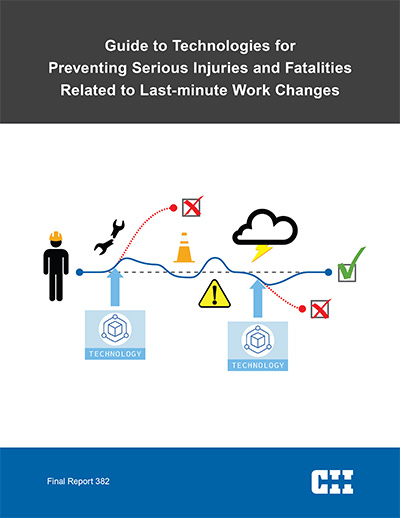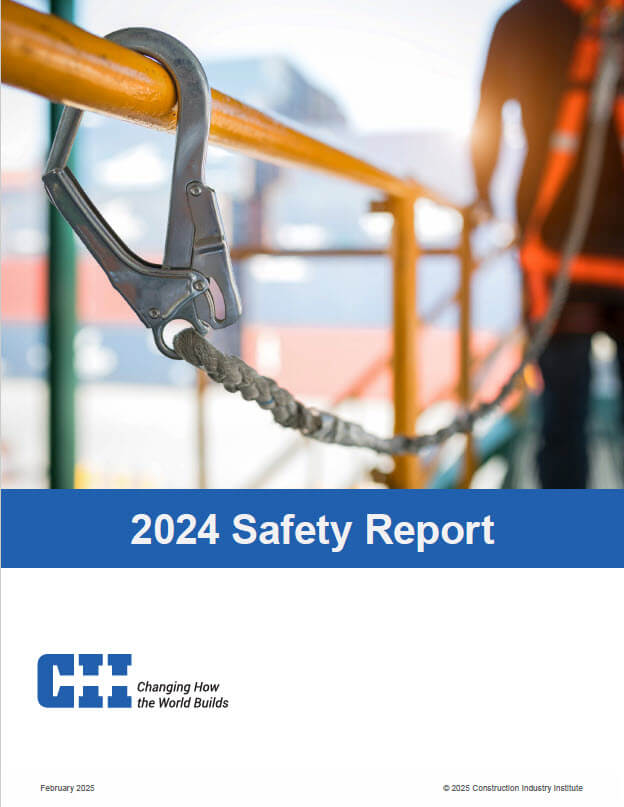
Guide to Technologies for Preventing Serious Injuries and Fatalities Related to Last-minute Work Changes
Unforeseen changes in work site conditions or work operations can be stressful, but especially in last-minute situations when workers are under time constraints. In some instances, the time pressure can lead to distractions, frustration, and poor decisions. In the field, however, a poor safety decision made in response to a last-minute change can result in a serious injury or fatality.
RT-382 found that last-minute changes play a role in the majority of SIF incidents. To respond to this situation, the team explored the idea of using technologies to prevent and/or mitigate the impacts of last-minute work changes that could lead to serious injury or even fatalities.
RT-382 mapped the catalog of technologies to the functional requirements: real-time monitoring, assessing, decision-making, and taking action. The team found that most present systems lack the robust capabilities required. Only two types of technologies could perform all of the functions required to address last-minute changes – AI and site control and site access technologies – but neither is currently ready and trusted. The team concluded that the industry needs to continue its investment in technological development, especially in robotics and AI.
RT-382 identified 40 currently available technologies that potentially are able to help mitigate last-minute changes to prevent SIFs. The technologies have a variety of capabilities and applications, and are at various stages of readiness for implementation (FR-382, p. 11).
The team organized these technologies into seven categories:
- Communications and Mobile Computing
- Sensing
- Visualization
- Monitoring
- Automation
- Site Control and Site Access
- Artificial Intelligence
Figure 1. Detail from the Technology Catalog
By reviewing 179 cases reported in the NIOSH Fatality Assessment and Control Evaluation (FACE) Program, RT-382 exposed the connection between last-minute changes and SIFs. When a change was a factor in the fatality incident, approximately 71% of the changes could be classified as last-minute changes. For all the FACE cases reviewed, gravity and motion were the predominant types of energy that led to the fatality incident (FR-382, p. 26):
RT-382’s analysis of NIOSH FACE cases revealed that the most common types of last-minute changes associated with SIF incidents were related to equipment usage, the work process, and worker/equipment path. These results suggest that two types of technologies could have a significantly positive impact on preventing SIFs (FR-382, p. 28):
- Technologies that detect and mitigate hazardous last-minute changes in human-equipment proximity.
- Technologies that detect and mitigate last-minute changes in the planned work process.
RT-382’s in-depth study of technology capabilities and the skills and competencies required in the face of last-minute changes enabled the team to map the technologies to the cognitive process that workers must take when a last-minute change occurs. The process included the following steps:
- Monitoring the work process and conditions
- Identifying that a change has occurred and comprehending what it was
- Determining options for responding to the change
- Selecting the best option
- Deciding to implement that option
- Implementing the selected option.
The team’s analysis revealed the limitations of current technologies in fulfilling all of these skills and competencies (FR-382, p. 55).
Technology adoption protocols help an organization decide whether to adopt a technology. After using an extensive literature review and the Delphi technique to gain consensus, RT-382 developed a process to aid the decision whether to adopt a technology for mitigating last-minute changes, along with guiding which of the adoption factors to consider (FR-382, p. 50). The process involves three steps:
- A high-level preliminary assessment
- A detailed assessment of organizational, individual, external, technology, and vendor implications
- A field assessment to certify the technology’s positive impact on last-minute changes



